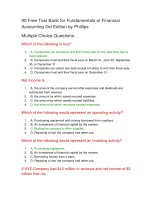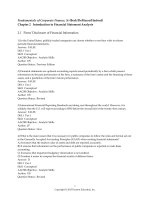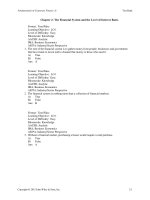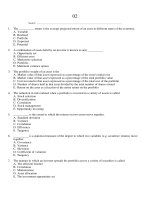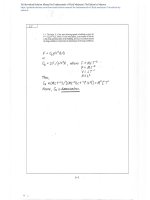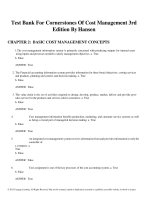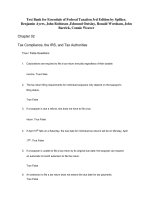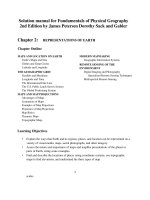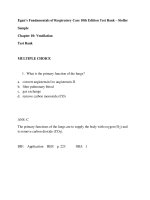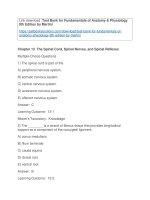90 free test bank for fundamentals of financial accounting 3rd edition by phillips
Bạn đang xem bản rút gọn của tài liệu. Xem và tải ngay bản đầy đủ của tài liệu tại đây (122.58 KB, 23 trang )
90 Free Test Bank for Fundamentals of Financial
Accounting 3rd Edition by Phillips
Multiple Choice Questions
Which of the following is true?
1.
A. Companies can choose to end their fiscal year on any date they feel is
most relevant.
2.
B. Companies must end their fiscal year on March 31, June 30, September
30, or December 31.
3.
C. Companies can select any date except a holiday to end their fiscal year.
4.
D. Companies must end their fiscal year on December 31.
Net Income is
1.
A. the amount the company earned after expenses and dividends are
subtracted from revenue.
2.
B. the amount by which assets exceed expenses.
3.
C. the amount by which assets exceed liabilities.
4.
D. the amount by which revenues exceed expenses.
Which of the following would represent an operating activity?
1.
A. Purchasing equipment with money borrowed from creditors.
2.
B. An investment of financial capital by the owners.
3.
C. Buying the company's office supplies.
4.
D. Repaying a loan the company had taken out.
Which of the following would represent an investing activity?
1.
A. Purchasing equipment.
2.
B. An investment of financial capital by the owners.
3.
C. Borrowing money from a bank.
4.
D. Repaying a loan the company had taken out.
If XYZ Company had $12 million in revenue and net income of $3
million then its:
1.
A. expenses must have been $15 million.
2.
B. expenses must have been $9 million.
3.
C. assets must have been $12 million.
4.
D. assets must have been $3 million.
Which of the following would not represent a financing activity?
1.
A. Paying dividends to stockholders.
2.
B. An investment of financial capital by the owners.
3.
4.
C. Borrowing money from a bank to finance the purchase of new
equipment.
D. Collecting cash from customers.
Which of the following would affect stockholders' equity?
1.
A. A company borrows $100 million and buys $100 million in equipment.
2.
B. A company pays $100 million to stockholders as a dividend.
3.
C. A company sells $100 million in assets for $100 million cash.
4.
D. A company receives payment for $100 million in accounts receivable.
Financial statements are most commonly prepared:
1.
A. semi-monthly.
2.
B. monthly, quarterly and annually.
3.
C. whenever management feels like it.
4.
D. weekly.
Assets:
1.
A. represent the amounts earned by a company.
2.
B. must equal the liabilities of a company.
3.
C. must equal the stockholders' equity of the company.
4.
D. represent the resources owned by a company.
The three main types of business activities measured by financial
statements are:
1.
A. selling goods, selling services, and obtaining financing.
2.
B. operating activities, investing activities, and financing activities.
3.
C. hiring, producing, and advertising.
4.
D. generating revenues, paying expenses, and paying dividends.
Expenses are shown
1.
A. on the income statement in the time period in which they are paid.
2.
B. on the income statement in the time period in which they are incurred.
3.
C. on the balance sheet in the time period in which they are paid.
4.
D. on the balance sheet in the time period in which they are incurred.
A company's balance sheet contained the following information:
contributed capital: $12,000; accounts payable:$64,000; Total
assets:$176,000; Retained Earnings: $28,000. Assume Notes
Payable is the only other item on the balance sheet. Notes
Payable must equal
1.
A. $200,000.
2.
B. $8,000.
3.
C. $72,000.
4.
D. $344,000.
The Don't Bite Me Pest Control Company has 10,000 gallons of
insecticide supplies on hand that cost $300,000; a bill from the
vendor for $100,000 of these supplies has not yet been paid. The
company expects to earn $800,000 for its services when it uses
the insecticide supplies. The company would report a supplies
asset in the amount of
1.
A. $10,000
2.
B. $200,000.
3.
C. $300,000
4.
D. $800,000
The separate entity assumption means:
1.
A. a company's financial statements reflect only the business activities of
that company.
2.
B. each separate owner's finances must be revealed in the financial
statements.
3.
C. each separate entity that has a claim on a company's assets must be
shown in the financial statements.
4.
D. if the business is a sole proprietorship, the owners' personal activities
are included in the company's financial statements.
Operating activities:
1.
A. involve day to day events related to production and sales.
2.
B. relate to the acquisition or sale of long-term assets.
3.
C. only involve financial exchanges.
4.
D. involve the payment of dividends to owners.
Which of the following are the three basic elements of the balance
sheet?
1.
A. assets, liabilities, and retained earnings.
2.
B. assets, liabilities, and contributed capital.
3.
C. assets, liabilities, and revenues.
4.
D. assets, liabilities, and stockholders' equity.
Financing that individuals or institutions have provided to a
company is
1.
2.
3.
4.
A. always classified as liabilities.
B. classified as liabilities when provided by creditors and stockholders'
equity when provided by owners.
C. always classified as equity.
D. classified as stockholders' equity when provided by creditors and
liabilities when provided by owners.
Cash flow from investing activities includes
1.
A. money received from a company's stockholders for the sale of stock.
2.
B. money received from the sale of the company's office building.
3.
C. money paid for dividends to the company's stockholders.
4.
D. money paid for salaries of employees.
During its first year of operations, Widgets Incorporated reported
sales revenue of $386,000 but collected only $303,000 from
customers. The amount to be reported as accounts receivable at
the end of the year is
1.
A. $689,000.
2.
B. $386,000.
3.
C. $303,000.
4.
D. $83,000.
Accounting information systems:
1.
2.
3.
A. are summarized by reports that are published to the public.
B. capture and report the results of a business's operating, investing, and
financing activities.
C. monitor business activities only in financial terms.
4.
D. capture only the information that is needed by the owners of the
company.
The Publish or Perish Printing Company paid a dividend to
stockholders. This will be reported on the:
1.
A. audit report.
2.
B. income statement.
3.
C. balance sheet.
4.
D. statement of retained earnings.
Creditors are:
1.
A. people or organizations who owe money to a business.
2.
B. people or organizations to whom a business owes money.
3.
C. stockholders of a business.
4.
D. customers of a business.
The Whackem-Smackem Software Company sold $11 million of
computer games in its first year of operations. The company
received payments of $7.5 million for these computer games. The
company's income statement would report:
1.
A. sales revenue of $7.5 million.
2.
B. accounts receivable of $3.5 million.
3.
C. expenses of $3.5 million.
4.
D. sales revenue of $11 million.
Investing activities:
1.
A. involve day to day events like selling goods and services, which occur
when running a business.
2.
B. involve the buying or selling of land, buildings, equipment, and other
long-term investments.
3.
C. involve the receipt of interest from short-term investments such as
certificates of deposits (CD's).
4.
D. involve the payment of wages, rent and other costs of running a
business.
Dividends are reported on the:
1.
A. Income statement.
2.
B. Balance sheet.
3.
C. Statement of retained earnings.
4.
D. Income statement and balance sheet.
Which of the following is not true?
1.
A. Assets = Liabilities + Stockholders' Equity
2.
B. Liabilities = Assets - Stockholders' Equity
3.
C. Stockholders' Equity + Liabilities - Assets = 0
4.
D. Liabilities - Stockholders' Equity = Assets
At the end of last year, the company's assets totaled $860,000
and its liabilities totaled $740,000. During the current year, the
company's total assets increased by $58,000 and its total
liabilities increased by $24,000. At the end of the current year,
stockholders' equity was
1.
A. $154,000.
2.
B. $120,000.
3.
C. $34,000.
4.
D. $178,000.
Public corporations:
1.
2.
A. are businesses owned by two or more people, each of whom is
personally liable for the debts of the business.
B. are businesses whose stock is bought and sold on a stock exchange.
3.
C. are businesses whose stock is bought and sold privately.
4.
D. are businesses where stock is not used as evidence of ownership.
90 Free Test Bank for Fundamentals of Financial
Accounting 3rd Edition by Phillips Multiple Choice
Questions - Page 2
What would a financial statement user learn from reading the
auditors' report?
1.
A. Whether the financial statements present a fair picture of the company's
financial results and are prepared in accordance with GAAP.
2.
B. Whether or not it is a good time to purchase the stock.
3.
C. What the company plans to distribute as dividends.
4.
D. Whether or not the company has plans for future expansion.
The WC Company borrowed $26,500 from a bank during 2010.
1.
A. This would be listed as ($26,500) under investing activities on the
statement of cash flows.
2.
B. This would be listed as ($26,500) under operating activities on the
statement of cash flows.
3.
C. This would be listed as $26,500 under investing activities on the
statement of cash flows.
4.
D. This would be listed as $26,500 under financing activities on the
statement of cash flows.
A company's quarterly income statements show that in the last
three quarters both sales revenue and net income have been
falling. Which of the following conclusions drawn by users are
valid, given this information?
1.
A. Creditors are likely to conclude that the risk of lending to the company is
falling and might be willing to accept a lower interest rate on loans.
2.
B. Investors are likely to conclude that the stock price is likely to rise,
making the company more attractive as a potential investment.
3.
C. Investors are likely to conclude that the company is more attractive as a
potential investment.
4.
D. Owners may conclude that the company will be less likely to distribute
dividends.
A creditor might look at a company's financial statements to
determine if the:
1.
A. company is likely to have the resources to repay its debts.
2.
B. company's stock is likely to fall, signaling a good time to sell.
3.
C. company's stock is likely to rise, signaling a good time to buy.
4.
D. company's stock is likely to vary up and down.
In the U.S., generally accepted accounting principles are
established:
1.
A. directly by the 1933 Securities Act.
2.
B. by the Public Company Accounting Oversight Board(PCAOB).
3.
C. by the Financial Accounting Standards Board(FASB).
4.
D. by the American Institute of Certified Public Accountants (AICPA).
If a company uses $50,000 of its cash to buy an asset then:
1.
A. assets and liabilities will be unchanged.
2.
B. assets will rise $50,000 as will liabilities.
3.
C. assets will rise $50,000 as will stockholders' equity.
4.
D. assets will fall $50,000 and liabilities will rise $50,000.
Which of the following would not affect a company's net income?
1.
A. A change in the company's income taxes.
2.
B. Changing the selling price of a company's product.
3.
C. Paying a dividend to stockholders.
4.
D. Advertising a new product.
Which of the following is true about the format of financial
statements?
1.
A. A double underline is drawn below the subtotal for total liabilities on the
balance sheet.
2.
B. Dollar signs are omitted if the heading states that amounts are reported
in U.S. dollars.
3.
C. Dividends are reported in parenthesis on the statement of retained
earnings.
4.
D. The heading of each financial statement indicates who, when, and what
in that particular order.
In the U.S., public companies have to be audited by independent
auditors using rules approved by the:
1.
A. 1933 Securities Act.
2.
B. Public Company Accounting Oversight Board (PCAOB).
3.
C. Financial Accounting Standards Board (FASB).
4.
D. American Institute of Certified Public Accountants (AICPA).
An investor might look at a company's financial statements to
determine:
1.
A. if competitors' earnings are rising or falling.
2.
B. if the company's stock is likely to fall, signaling a good time to sell.
3.
C. if the company's creditors are having a good year.
4.
D. if the company's owners are financially sound.
The purpose of a statement of retained earnings is to:
1.
2.
A. estimate the current value of a company's assets.
B. report how the profits of a company have been distributed to
stockholders or retained in the business.
3.
C. show where the money is flowing into and out of a company.
4.
D. explain the specific revenues and expenses arising during the period.
Which of the following is not a difference between notes payable
and accounts payable?
1.
A. Notes payable are not interest free while accounts payable may be
interest free.
2.
B. Notes payable can remain unpaid longer than accounts payable.
3.
C. Notes payable are documented using formal written debt contracts while
accounts payable are generally informal.
4.
D. Notes payable are not reported as liabilities on the balance sheet while
accounts payable are reported as liabilities on the balance sheet.
Which of the following statements is not true concerning the notes
to the financial statements?
1.
A. Notes to the financial statements explain what policies were used to
prepare the financial statements.
2.
B. Notes to the financial statements provide additional information about
what is included in the financial statements.
3.
C. Notes to the financial statements provide additional information about
financial matters that are not included in the financial statements.
4.
D. Notes to the financial statements provide financial information about the
owners of the business.
Internal users of financial data include:
1.
A. investors.
2.
B. creditors.
3.
C. management.
4.
D. regulatory authorities.
Which of the following is not an expense?
1.
A. Wages of employees.
2.
B. Interest incurred on a loan the company had taken out.
3.
C. Dividends.
4.
D. Corporate income tax.
Which of the following would not be acceptable as an alternative
term used for the income statement?
1.
A. Statement of Operations.
2.
B. Statement of Financial Position.
3.
C. Statement of Earnings.
4.
D. Profit and Loss Statement.
Generally accepted accounting principles (GAAP) were (are)
established by:
1.
A. an Italian monk in 1494.
2.
B. the U.S. Congress in 1933.
3.
C. the PCAOB in 2004.
4.
D. the FASB.
To determine whether generally accepted accounting principles
(GAAP) were followed in the preparation of financial statements,
an examination of:
1.
A. tax documents would be performed by the IRS.
2.
B. the annual report would be performed by the SEC.
3.
C. the financial statements and related documents would be performed by
an independent auditor.
4.
D. the financial statements and related documents would be performed by
the FASB.
Which of the following business organizations has only one
owner?
1.
A. A corporation.
2.
B. A sole proprietorship.
3.
C. A public company.
4.
D. A partnership.
Which of the following would be reported on the income
statement for 2010?
1.
A. Supplies that were purchased and used in 2009 but paid for in 2010.
2.
B. Dividends that were paid in 2010.
3.
C. Supplies that were purchased, used, and paid for in 2010.
4.
D. Supplies that were purchased in 2009 and paid for in 2010 but have not
been used.
Investors are often interested in the amount of net income
distributed as dividends. In which section of the financial
statements would investors look to find this amount?
1.
A. Statement of retained earnings.
2.
B. Balance sheet.
3.
C. Notes to the financial statements.
4.
D. Income statement.
Every financial statement should have "who, what, and when" in
its heading. These are:
1.
A. the name of the person preparing the statement, the type of financial
statement, and when the financial statement was reported to the SEC.
2.
B. the name of the person preparing the statement, the name of the
company, and the date the statement was prepared.
3.
C. the name of the company, the type of financial statement, and the time
period or date from which the data were taken.
4.
D. the name of the company, the purpose of the statement, and when the
financial statement was reported to the IRS.
During 2010, a company's assets rise $56,000 and its liabilities
rise $38,000. If no dividend is paid and no further capital is
contributed, net income for 2010 was:
1.
A. $56,000.
2.
B. $18,000.
3.
C. $94,000.
4.
D. $38,000
Investors and creditors look at the balance sheet to see whether
the company
1.
A. is profitable.
2.
B. owns enough assets to pay what it owes to creditors.
3.
C. has had a positive cash flow from operations.
4.
D. is paying sufficient dividends to stockholders.
90 Free Test Bank for Fundamentals of Financial
Accounting 3rd Edition by Phillips Multiple Choice
Questions - Page 3
Which of the following statements concerning financial reporting
is FALSE?
1.
A. Accounting rules in the U.S. are called GAAP.
2.
B. Accounting rules developed by the IASB are called IFRS.
3.
C. Both GAAP and IFRS share the same goal which is to ensure useful
information to users of financial statements.
4.
D. There are no differences between the accounting rules developed by
FASB and those developed by IASB.
A company issued stock to investors for cash of $50,000. Choose
the TRUE statement.
1.
A. Cash will increase $50,000 and contributed capital will increase $50,000.
2.
3.
4.
B. Cash will decrease $50,000 and retained earnings will decrease
$50,000.
C. Cash will increase $50,000 and retained earnings will increase $50,000.
D. Cash will decrease $50,000 and contributed capital will increase
$50,000.
The Income Statement
1.
A. reports the amount of Assets of a company.
2.
B. reports results of operations in physical measures.
3.
C. reports the amount of profit distributed to owners during the period.
4.
D. reports the amount of revenues earned and expenses incurred during
the period.
A company began the year with assets of $100,000 and liabilities
of $75,000. During the year assets increased by $12,000 and
liabilities decreased by $9,000. What is the amount of the change
in stockholders' equity during the year?
1.
A. $3,000 increase
2.
B. $21,000 increase
3.
C. $21,000 decrease
4.
D. $3,000 decrease
The statement of cash flows shows the following information:
Cash flows from operating activities: $16,500; Cash flows
investing activities: $8,400; Cash flows from financing activities:
$2,900. The beginning cash was $14,000. What is the amount of
cash at the end of the period?
1.
A. $41,800
2.
B. $30,500
3.
C. $8,800
4.
D. $19,200
A company began the year with assets of $100,000 and liabilities
of $75,000. During the year assets increased by $12,000 and
liabilities decreased by $9,000. What is the amount of
stockholders' equity at the beginning of the year?
1.
A. Zero
2.
B. $25,000
3.
C. $175,000
4.
D. $100,000
The first year of operations for a company was 2010. The net
income for the year 2010 was $20,000 and dividends of $12,000
were paid. In 2011, the company reported net income of $34,000
and paid dividends of $5,000. At the end of 2010, the company
had total assets of $150,000, and at the end of 2011, total assets
were $240,000. What is the amount of retained earnings at the
end of 2011?
1.
A. $37,000
2.
B. $240,000
3.
C. $29,000
4.
D. $269,000
Which of the following would be reported on the income
statement for the year?
1.
A. The amount of Cash at the end of the year.
2.
B. The amount of Supplies used up during the current year.
3.
C. The amount of dividends distributed to owners during the current year.
4.
D. The amount of unpaid employee wages at the end of the year.
The statement of cash flows for a company contained the
following:Cash flows from operating activities: $29,000; Cash
flows investing activities: $30,000; Cash flows from financing
activities: $45,000. What was the change in cash for the period?
1.
A. $14,000 increase
2.
B. $15,000 increase
3.
C. $14,000 decrease
4.
D. $15,000 decrease
A legal document called a stock certificate is used to indicate
ownership in a
1.
A. Corporation
2.
B. Sole proprietorship
3.
C. Partnership
4.
D. Both sole proprietorship and partnership
In this period, a company recorded sales revenue of $50,000 from
sales of goods to customers who agreed to pay later. In the next
period, the company received payment from customers of
$45,000. Choose the TRUE statement.
1.
A. Revenue for this period is $45,000.
2.
B. Accounts receivable at the end of this period is $5,000.
3.
C. Accounts payable at the end of this period is $5,000.
4.
D. Cash for next period will increase by $50,000.
A company incurred $2,000 for utilities for the last month of the
year. The company has not paid this bill yet. Choose the TRUE
statement.
1.
2.
A. $2,000 should be reported on the income statement as Utilities Expense.
B. Nothing should be reported about this in the current year's financial
statements.
3.
C. $2,000 should be reported as Accounts receivable on the Balance Sheet
at the end of the year.
4.
D. $2,000 should be reported as Utilities Expense on the Balance Sheet at
the end of the year.
For the current year, the first year of operations, a company sold
$100,000 of goods to customers and received $90,000 in cash
from customers. The remainder is owed to the company at the
end of the year. The company incurred $70,000 in expenses for
the year and paid $65,000 of these in cash. The remainder is
owed by the company at the end of the year. Based on this
information, what is the amount of net income for the year?
1.
A. $25,000
2.
B. $35,000
3.
C. $20,000
4.
D. $30,000
Which of the following would be reported on the income
statement for the current year?
1.
A. In the current year, the company sold goods to customers who agreed to
pay next year.
2.
B. In the current year, the company received payment in cash for goods
that were sold to customers last year.
3.
C. In the current year, the company borrowed money from the bank which
is to be used in the business activities this year.
4.
D. In the current year, the company issued stock to owners and received
cash immediately.
A company incurred $5,000 in wages for employees for the year.
$4,500 of these wages were paid by the end of the year. Choose
the TRUE statement.
1.
A. Wages payable on the income statement will be $4,500.
2.
B. Wages expense on the income statement will be $500.
3.
C. Wages expense on the balance sheet will be $5,000.
4.
D. Wages payable on the balance sheet will be $500.
The first year of operations for a company was 2010. The net
income for the year 2010 was $20,000 and dividends of $12,000
were paid. In 2011, the company reported net income of $34,000
and paid dividends of $5,000. At the end of 2010, the company
had total assets of $150,000, and at the end of 2011, total assets
were $240,000.What is the amount of net income for the year
2011?
1.
A. $3,825
2.
B. $1,825
3.
C. $10,300
4.
D. $5,625
Relevance is an objective of external financial reporting and
means
1.
A. the financial reports of a business are assumed to include the results of
only that business's activities.
2.
B. financial information can be compared across businesses because
similar accounting methods have been applied.
3.
C. the financial information possesses a feature that allows it to influence a
decision.
4.
D. the financial information depicts the economic substance of business
activities.
The first year of operations for a company was 2010. The net
income for the year 2010 was $20,000 and dividends of $12,000
were paid. In 2011, the company reported net income of $34,000
and paid dividends of $5,000. At the end of 2010, the company
had total assets of $150,000, and at the end of 2011, total assets
were $240,000. What was the amount of retained earnings at the
end of 2010?
1.
A. $20,000
2.
B. $8,000
3.
C. $150,000
4.
D. $155,000
Choose the TRUE statement.
1.
A. A company with Net Income will also have a cash increase from
operating activities.
2.
B. A company with Liabilities of $80,000 and Stockholders' equity of
$50,000 will have Assets of $30,000.
3.
C. If a company has total revenues of $80,000, total expenses of $50,000
and dividends of $10,000, they will have net income of $20,000.
4.
D. A company with total stockholders' equity of $120,000 and $75,000 of
contributed capital must have total retained earnings of $45,000.
Stockholders' equity is
1.
A. a liability of the business.
2.
B. an economic resource controlled by the business.
3.
C. the owners' claims on the business.
4.
D. the profit generated by the business.
At the end of the current year, a company paid cash to acquire a
storage facility with plans to use it in its business activities for
several years. Choose the TRUE statement.
1.
A. In the current year, total assets will decrease and stockholders' equity
will decrease.
2.
B. In the current year, total assets will decrease and stockholders' equity
will increase.
3.
C. This year, this activity will be reported as a cash outflow from investing
activities on the Statement of Cash Flows.
4.
D. This year, this activity will not result in any changes to the balance sheet
or the income statement.
A company sold goods to customers and received cash. Choose
the FALSE statement.
1.
A. Revenue will increase on the income statement.
2.
B. Assets will increase on the balance sheet.
3.
C. Stockholders' equity will increase on the balance sheet.
4.
D. Expenses will decrease on the income statement.
The first year of operations for a company was 2010. The net
income for the year 2010 was $20,000 and dividends of $12,000
were paid. In 2011, the company reported net income of $34,000
and paid dividends of $5,000. At the end of 2010, the company
had total assets of $150,000, and at the end of 2011, total assets
were $240,000.What is the amount of total assets at the end of
2011?
1.
A. $16,800
2.
B. $16,500
3.
C. $21,600
4.
D. $23,500
A company began the year with Assets of $100,000, Liabilities of
$20,000 and Stockholders' equity of $80,000. During the year
Assets increased $55,000 and stockholders' equity increased
$20,000. What was the change in Liabilities for the year?
1.
A. Increase of $75,000
2.
B. Increase of $35,000
3.
C. Decrease of $75,000
4.
D. Decrease of $35,000
Faithful representation is a characteristic of external financial
reporting that means
1.
A. the financial reports of a business are assumed to include the results of
only that business's activities.
2.
B. financial information can be compared across businesses because
similar accounting methods are applied.
3.
C. the results of business activities are reported using an appropriate
monetary unit.
4.
D. financial information depicts the economic substance of business
activities.
Which of the following statements concerning financial reporting
is TRUE?
1.
A. The FASB requires all financial decision makers to adhere to a code of
professional conduct.
2.
B. The Sarbanes-Oxley Act does not require businesses to maintain an
audited system of internal control.
3.
C. A fundamental characteristic of useful financial information is that it fully
depicts the economic substance of business activities.
4.
D. There is no attempt to eliminate the difference in accounting rules in the
U.S. and elsewhere as this would not allow investors to more easily compare
financial statements of companies from different countries.
The separate entity assumption means
1.
A. the financial information depicts the economic substance of the business
activities.
2.
B. the financial reports of a business are assumed to include the results of
only that business's activities.
3.
C. the results of business activities are reported in an appropriate monetary
unit.
4.
D. the financial information can be compared across businesses because
similar accounting methods have been applied.
At the end of the current year, a company purchased and paid
cash of $100,000 for a piece of equipment to be used for several
years in the business. Choose the TRUE statement.
1.
A. On the Statement of Cash Flows, $100,000 will be shown as a cash
inflow from investing activities.
2.
B. On the Statement of Cash Flows, $100,000 will be shown as a cash
outflow from financing activities.
3.
C. On the Balance Sheet at the end of the year, Total Assets will not
change as a result of this purchase.
4.
D. On the Income Statement, $100,000 will be reported as Equipment
Expense.
The first year of operations for a company was 2010. The net
income for the year 2010 was $20,000 and dividends of $12,000
were paid. In 2011, the company reported net income of $34,000
and paid dividends of $5,000. At the end of 2010, the company
had total assets of $150,000, and at the end of 2011, total assets
were $240,000. What is the amount of total liabilities at the end of
2011?
1.
A. $7,075
2.
B. $10,075
3.
C. $9,075
4.
D. $12,975
The first year of operations for a company was 2010. The net
income for the year 2010 was $20,000 and dividends of $12,000
were paid. In 2011, the company reported net income of $34,000
and paid dividends of $5,000. At the end of 2010, the company
had total assets of $150,000, and at the end of 2011, total assets
were $240,000. What is the amount of retained earnings on the
Balance Sheet at the end of 2011?
1.
A. $7,725
2.
B. $6,725
3.
C. $4,800
4.
D. $4,725
Assets reported on the balance sheet would include which of the
following?
1.
A. Accounts receivable, sales revenue and cash
2.
B. Equipment, supplies expense and cash
3.
C. Accounts payable, retained earnings and cash
4.
D. Accounts receivable, equipment and cash
Which of the following statements is FALSE?
1.
A. Cash flows from financing activities would appear on the Statement of
Cash Flows.
2.
B. Dividends would appear on the Statement of Retained Earnings.
3.
C. Assets would appear on the Income Statement.
4.
D. Revenues would appear on the Income Statement.
Liabilities on the balance sheet would include which of the
following?
1.
A. Accounts payable, notes payable and contributed capital
2.
B. Accounts receivable, supplies expense and retained earnings
3.
C. Accounts payable, notes payable and wages payable
4.
D. Contributed capital, retained earnings and notes payable
Which of the following statements about organizational forms of a
business is FALSE?
1.
A. In a sole proprietorship form of business or in a partnership form, the
owner(s) are personally responsible for the debts of the business.
2.
B. The partnership agreement states how profits are to be shared between
partners and what happens when a new partner is to be admitted or an
existing partner is retiring.
3.
C. A corporation is a separate entity from both a legal and accounting
perspective.
4.
D. The owners of a corporation are legally responsible for the corporation's
debts and taxes.
Investing activities on the Statement of Cash Flows are
1.
2.
A. transactions with lenders, borrowing and repaying cash.
B. transactions with stockholders, selling company stock and paying
dividends.
3.
C. activities directly related to running the business to earn profit.
4.
D. buying and selling productive resources with long lives.
Which of the following would not appear as a possible asset on
the balance sheet?
1.
A. Accounts receivable
2.
B. Supplies
3.
C. Retained earnings
4.
D. Cash
Which of the following statements is false?
1.
A. When choosing between a company that pays steady dividends and one
that retains its earnings to support future growth, investors will always
choose the company that pays steady dividends.
2.
B. Companies can develop reputations for honest financial reporting even
when conveying bad news.
3.
C. Trends in a company's net income from year to year can provide clues
about its future earnings, which can help investors to decide whether to buy
stock in the company.
4.
D. Information in the notes to the financial statements can influence a
user's interpretation of balance sheet and income statement information.
Which of the following would not appear as a possible liability on
the balance sheet?
